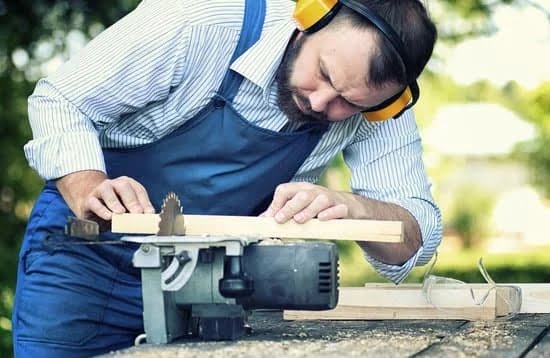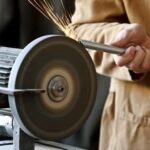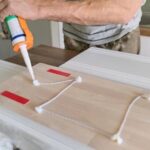What is a good woodworking bench top to use? The choice of a woodworking bench top is crucial for the quality and efficiency of any woodworking project. A sturdy and reliable work surface not only provides stability and support but also contributes to the precision and accuracy of the work.
In this article, we will explore the different types of woodworking bench tops, their durability and stability factors, work surface considerations, ideal size and dimensions, vises and clamping options, as well as surface protection and maintenance. Choosing the right woodworking bench top is essential for a successful woodworking experience.
When it comes to woodworking bench tops, there are various options available, each with its own set of pros and cons. Whether it’s solid wood, laminated wood, or MDF (medium-density fiberboard), understanding the characteristics of different materials can help in making an informed decision. Additionally, factors such as material thickness, joinery, construction, work surface flatness, smoothness, and sturdiness all play vital roles in determining the suitability of a bench top for specific projects.
The size and dimensions of a woodworking bench top also impact its usability and functionality in a workshop setting. Understanding the ideal size based on the type of projects being pursued as well as the available space in the workshop is essential for optimizing productivity. And lastly but importantly are tips on maintaining suitable conditions to protect your investment from harm so that you benefit from its use for years to come.
Types of Woodworking Bench Tops
Solid wood, laminated wood, and MDF are three common types of materials used for woodworking bench tops. Each material has its own unique characteristics and advantages, making it important to consider the specific needs and preferences of the woodworker when choosing the right type of bench top.
Solid wood bench tops are known for their natural beauty and durability. They are generally made from hardwoods such as maple, oak, or beech, which can withstand heavy-duty use and provide a sturdy work surface. However, solid wood bench tops may be more susceptible to warping or shrinking due to changes in humidity and temperature, requiring regular maintenance to keep them in top condition.
Laminated wood bench tops are constructed by gluing together multiple layers of hardwood to create a strong and stable work surface. This construction method helps prevent warping and enhances the overall durability of the bench top. Laminated wood also offers a smooth and even work surface for precision woodworking projects. However, laminated bench tops may be more expensive than other options.
MDF (medium-density fiberboard) bench tops are an affordable choice that offers a flat and uniform work surface. While not as durable as solid wood or laminated wood, MDF is still a popular option for woodworking benches due to its cost-effectiveness. It is important to note that MDF can be more prone to moisture damage compared to other materials, so proper sealing or finishing is essential to protect the bench top from swelling or warping.
| Type of Bench Top | Pros | Cons |
|---|---|---|
| Solid Wood | Natural beauty, durability | Potential for warping, requires regular maintenance |
| Laminated Wood | Strong and stable work surface, prevents warping | Higher cost |
| MDF (Medium-Density Fiberboard) | Affordable option, flat work surface | Prone to moisture damage |
Durability and Stability
When it comes to woodworking, having a durable and stable bench top is crucial for the quality of work and overall safety in the workshop. The durability and stability of a woodworking bench top are determined by several factors, including material thickness, joinery, and construction. Understanding these factors can help woodworkers make informed decisions when choosing the right bench top for their projects.
Material Thickness
The thickness of the material used for the bench top plays a significant role in its durability and stability. Thicker materials such as hardwoods or laminated wood tend to be more robust and resistant to warping or bowing over time. For heavy-duty projects that involve pounding or chiseling, a thicker bench top is highly recommended to withstand the pressure and prevent damage.
Joinery
The way in which the components of the bench top are joined together also impacts its overall strength and stability. Traditional joinery techniques such as dovetails, mortise and tenon, or dowels can provide superior strength compared to modern fastening methods like screws or nails. Properly executed joinery ensures that the bench top remains solid and secure during woodworking tasks.
Construction
The overall construction of the woodworking bench top contributes significantly to its durability and stability. A well-built bench top with sturdy support structures, bracing, and reinforcement will be less prone to wobbling or shifting during use. Additionally, paying attention to details such as grain orientation, moisture content, and finishing techniques can further enhance the longevity of the bench top.
Considering these factors when selecting a woodworking bench top is essential for achieving consistent results and preventing potential safety hazards in the workshop. By prioritizing material thickness, joinery, and construction quality in their decision-making process, woodworkers can ensure that their chosen bench top meets their specific needs effectively while providing long-lasting performance.
Work Surface Considerations
When it comes to woodworking, having the right work surface is essential for ensuring the quality and precision of your projects. The work surface serves as the foundation for all your woodworking activities, providing a stable and reliable space for cutting, sanding, assembling, and finishing your creations. Here are some key considerations for choosing a work surface that meets the needs of your woodworking projects:
- Flatness: A flat work surface is crucial for achieving accurate cuts and joins in woodworking. Irregularities or uneven areas on the bench top can lead to flaws in your projects.
- Smoothness: A smooth work surface is important for facilitating movement of wood pieces during cutting and assembly. Rough surfaces can cause friction and damage delicate wood surfaces.
- Sturdiness: The work surface should be sturdy enough to support heavy materials and withstand the force applied during sawing, chiseling, and drilling. A flimsy workbench can compromise the safety and stability of your woodworking operations.
Considering these factors will help you choose a wood bench top that provides an optimal environment for carrying out your woodworking tasks efficiently and precisely. Whether you opt for solid wood, laminated wood, or MDF as your bench top material, make sure it meets these essential criteria.
In addition to these considerations, it’s also important to take into account the size of the work surface in relation to the dimensions of your workshop space and the types of projects you typically undertake. With a suitable work surface that meets all these criteria, you can elevate your woodworking experience and achieve outstanding results in your craft.
Now that you understand what makes a good woodworking bench top, let’s explore some recommended options available on the market that align with these important considerations.
Size and Dimensions
When it comes to woodworking bench tops, the size and dimensions play a crucial role in determining the suitability for different projects and the available space in the workshop. The ideal size and dimensions of a woodworking bench top will vary depending on the type of projects that will be undertaken and the amount of space available in the workshop.
Consideration for Project Type
The size and dimensions of a woodworking bench top should be chosen based on the type of projects that will be commonly undertaken. For larger projects such as furniture making or cabinetry, a larger bench top with more surface area is beneficial for handling large workpieces and providing ample space for assembly. On the other hand, for smaller projects such as carving or joinery work, a smaller bench top may suffice to conserve space in the workshop.
Workspace Constraints
It is important to take into account the available space in the workshop when deciding on the size and dimensions of a woodworking bench top. If space is limited, opting for a compact yet functional bench top may be necessary to ensure that there is still adequate room for maneuvering around the workshop. Additionally, considering any existing machinery or equipment in the workshop can also influence the size and placement of the woodworking bench top.
Customization Options
Many woodworkers prefer to have a customizable or adjustable bench top that can accommodate various project sizes and types. This allows for flexibility in adapting to different needs and working comfortably with different materials. Some woodworking enthusiasts even opt for modular bench tops that can be adjusted or expanded based on their specific project requirements.
Vises and Clamping
When it comes to woodworking, having a reliable and secure way to hold workpieces in place is crucial for achieving precise and accurate results. This is where vises and clamping systems come into play. There are various options available for adding these essential components to a woodworking bench top, each with its own unique features and benefits.
One common type of vise used in woodworking is the front vise, which is typically mounted at the front of the bench top and is ideal for holding boards or other workpieces flat on the surface. Another popular option is the tail vise, which can be installed at the end of the bench and provides support for longer pieces of wood.
Additionally, there are also shoulder vises and leg vises that can be added to a woodworking bench to accommodate different types of projects.
In addition to vises, clamping systems such as holdfasts, bench dogs, and clamps can also be integrated into the bench top to further enhance its functionality. Holdfasts are designed to secure workpieces in place by being hammered into corresponding holes on the bench top, while bench dogs can be used in conjunction with a dog hole system for versatile clamping options. Clamps can also be attached to the edges or sides of the bench top as needed for specific projects.
Overall, selecting the right vise and clamping system for a woodworking bench top depends on factors such as the type of projects you’ll be working on, your budget, and personal preferences in terms of design and ease of use.
| Vise/Clamp Type | Features |
|---|---|
| Front Vise | Ideal for holding boards or workpieces flat on the surface; typically mounted at the front of the bench top. |
| Tail Vise | Supports longer pieces of wood; mounted at the end of the bench. |
| Shoulder Vise/Leg Vise | Accommodates various project types. |
Surface Protection and Maintenance
Woodworking bench tops are an essential component of any woodworker’s workshop, providing a stable and durable work surface for various projects. However, to ensure the longevity of the bench top and maintain its quality, it is crucial to protect it from damage and perform regular maintenance. Surface protection and maintenance play a significant role in prolonging the lifespan of the woodworking bench top, ultimately impacting the overall woodworking experience.
One important aspect of protecting the bench top from damage is using protective measures such as applying a finish or sealant to the surface. A good quality finish not only enhances the appearance of the bench top but also provides a protective layer against moisture, scratches, and stains. It is essential to choose a finish that is compatible with the type of wood or material used for the bench top to ensure effective protection.
In addition to using a protective finish, regular maintenance is key to preserving the quality of the woodworking bench top. This includes keeping the surface clean and free from debris, regularly inspecting for any signs of wear or damage, and addressing any issues promptly.
Furthermore, it is important to follow proper care instructions based on the type of bench top material used, whether it be solid wood, laminated wood, MDF, or other materials. By implementing these surface protection and maintenance practices, woodworkers can prolong the lifespan of their bench tops and continue to enjoy a high-quality work surface for their projects.
Recommended Woodworking Bench Tops
When it comes to choosing a woodworking bench top, there are several options available on the market, each with its own unique features and benefits. The right bench top can greatly impact the quality of your work, so it’s important to carefully consider your needs and preferences when making a decision. Below are some popular and highly recommended woodworking bench tops that you may want to consider for your workshop:
- Solid Wood Bench Tops: Solid wood bench tops are prized for their natural beauty and durability. They provide a sturdy and stable work surface that is perfect for heavy-duty woodworking projects. However, they may be more susceptible to warping or staining if not properly maintained.
- Laminated Wood Bench Tops: Laminated wood bench tops are constructed by gluing together multiple layers of wood, resulting in a stable and flat work surface. They offer good durability and resistance to warping, making them a popular choice among woodworkers.
- MDF Bench Tops: Medium-density fiberboard (MDF) bench tops are an affordable option that provides a smooth and consistent work surface. While MDF is not as durable as solid wood or laminated wood, it is suitable for light to medium-duty woodworking tasks.
Before making a decision, it’s important to consider factors such as the type of projects you will be working on, the available space in your workshop, and your budget. Additionally, don’t forget to take into account any additional features you may need, such as built-in vises or clamping systems.
Whether you prioritize durability, aesthetics, or affordability in a woodworking bench top, there are options available that can meet your needs.
It’s always best to carefully research and compare different products before making a purchase to ensure that you select the best woodworking bench top for your specific requirements.
Conclusion
In conclusion, the choice of a woodworking bench top is crucial to the overall quality and success of your woodworking projects. The right bench top not only provides a sturdy and stable work surface but also ensures durability, flatness, and smoothness for precision work. With various options available, including solid wood, laminated wood, and MDF, it’s important to consider the pros and cons of each type based on your specific needs and preferences.
When considering what is a good woodworking bench top to use, factors such as material thickness, joinery, construction, size, and dimensions play a significant role in determining the suitability of the bench top for your workshop. Additionally, the addition of vises and clamping systems can enhance the functionality of the bench top by securely holding workpieces in place during woodworking tasks.
Furthermore, protecting the bench top from damage through regular maintenance is essential for prolonging its lifespan. Whether it’s applying a protective finish or using protective mats for heavy-duty use, these measures can contribute to maintaining the quality of the bench top over time. By carefully evaluating all these aspects and choosing a recommended woodworking bench top that aligns with your specific requirements, you can ensure a successful woodworking experience with reliable support from your work surface.
Frequently Asked Questions
What Is the Best Material for a Woodworking Bench Top?
The best material for a woodworking bench top is usually hardwood, such as maple, oak, or beech. These woods are known for their durability and resistance to wear and tear, making them ideal for a surface that will be subjected to heavy use and potential damage from tools.
What Kind of Wood Should I Use for a Bench Top?
When choosing wood for a bench top, it’s important to select a species that is hard enough to withstand dents and scratches from tools. Maple is a popular choice due to its hardness and resilience. Oak is another good option, known for its strength and stability. Beech is also commonly used for its toughness and resistance to wear.
How Thick Should a Woodworking Bench Top Be?
The thickness of a woodworking bench top depends on the intended use of the bench. For general woodworking tasks, a thickness of 3 inches or more is recommended to provide sufficient support and stability. Thicker bench tops can better withstand heavy pounding and pressure from hand tools or machinery, making them suitable for more demanding tasks.

Hi everyone! I’m a woodworker and blogger, and this is my woodworking blog. In my blog, I share tips and tricks for woodworkers of all skill levels, as well as project ideas that you can try yourself.





